List of presidents of Pakistan
- The head of state of Pakistan from independence until Pakistan became a republic in 1956 was the Pakistani monarch. For the Governor-Generals who represented them from 1947 to 1956, see Governor-General of Pakistan.

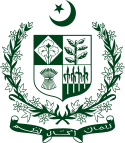 |
|---|
|
The president of Pakistan is the head of state of the Islamic Republic of Pakistan. According to the Constitution of Pakistan, the president has "powers, subject to Supreme Court approval or veto, to dissolve the National Assembly, triggering new elections, and thereby dismissing the prime minister".[1] These powers were repeatedly modified through amendments to the constitution, which were introduced as the results of military coups and changes in government. Since the 18th Amendment to the Constitution was passed in 2010, Pakistan has been shifted back from semi-presidential to a parliamentary republic. Under that system, the president has limited ruling powers, and performs ceremonial duties while the Prime Minister enjoys more powers to execute decisions.[2] The president is chosen by the Electoral College composed of the Senate, the National Assembly and the Provincial Assemblies.[3]
There have been thirteen presidents of Pakistan since the introduction of the post in 1956.[4] The office was established when Pakistan was declared as a republic with the adoption of the 1956 constitution, and Iskander Mirza became the first president of the country.[5][6] Until 1956, Pakistan was a dominion within the Commonwealth of Nations with Elizabeth II as the queen of Pakistan. Apart from these twelve, two acting presidents have also been in office for short periods of time. One of them, Wasim Sajjad, served as acting president on two non-consecutive occasions during 1993 and 1997–98.[7] The president may remain in office for a tenure of five years. In the case where a president's term of office is terminated early or during the absence of the president, the Chairman of the Senate assumes office.[3]
Six presidents have been members of a political party and four of them were active party members of the Pakistan Peoples Party (PPP). The first president was a retired military officer, four others were incumbent military officers of which three gained power through successful military coups in Pakistan's history – Ayub Khan in 1958, Muhammad Zia-ul-Haq in 1977 and Pervez Musharraf in 1999.[4][8] President Zia died in office when his aircraft crashed while returning from Bahawalpur to Islamabad on 17 August 1988.[9][10] Ayub Khan, during his two terms, remained in the office for the longest period with ten years and five months approximately.[n 1][11]
The current president of Pakistan is Arif Alvi of Pakistan Tehreek e Insaf.[12]
Line of succession and removal[]
The Constitution discusses the possibility of an acting president. in Chapter 1: The President, Part III: The Federation of Pakistan in the Constitution of Pakistan. Certain office-holders, however, are permitted to stand as presidential candidates in case of vacancy as the constitution does not include a position of vice president:
- The Chairman of the Senate of Pakistan
- The Speaker of the National Assembly of Pakistan. in Chapter 1: The President, Part III: The Federation of Pakistan in the Constitution of Pakistan.
Territory[]
The dominion began as a federation of five provinces: East Bengal (later to become Bangladesh), West Punjab, Balochistan, Sindh, and the North-West Frontier Province (NWFP). Each province had its own governor, who was appointed by the Governor-General of Pakistan. In addition, over the following year the princely states of Pakistan, which covered a significant area of West Pakistan, acceded to Pakistan. They included Bahawalpur, Khairpur, Swat, Dir, Hunza, Chitral, Makran, and the Khanate of Kalat.
Radcliffe Line[]
The controversial Radcliffe Award, not published until 17 August 1947 specified the Radcliffe Line which demarcated the border between the parts of British India allocated to the two new independent dominions of India and Pakistan. The Radcliffe Boundary Commission sought to separate the Muslim-majority regions in the east and northwest from the areas with a Hindu majority. This entailed the partition of two British provinces which did not have a uniform majority — Bengal and Punjab. The western part of Punjab became the Pakistani province of Punjab and the eastern part became the Indian state of Punjab. Bengal was similarly divided into East Bengal (in Pakistan) and West Bengal (in India).
The Radcliffe commission had no power to divide the territory of the princely states of India.
Monarchy of Pakistan[]
Under the Indian Independence Act 1947, British India was to be divided into the independent sovereign states of India and Pakistan. From 1947 to 1952, George VI was the sovereign of Pakistan, which shared the same person as its sovereign with the United Kingdom and the other Dominions in the British Commonwealth of Nations.[13][14]
Following George VI's death on 6 February 1952, his daughter Princess Elizabeth, who was in Kenya at that time, became the new monarch of Pakistan. During the Queen's coronation in 1953, Elizabeth II was crowned as Queen of seven independent Commonwealth countries, including Pakistan.[15] In her Coronation Oath, the new Queen promised "to govern the Peoples of ... Pakistan ... according to their respective laws and customs".[16] The Standard of Pakistan at the Coronation was borne by Mirza Abol Hassan Ispahani.[17]
Pakistan abolished the monarchy on the adoption of a republican constitution on 23 March 1956.[18] However, Pakistan became a republic within the Commonwealth of Nations. The Queen sent a message to Pakistanis which said, "I have followed with close interest the progress of your country since its establishment ... It is a source of great satisfaction to me to know that your country intends to remain the Commonwealth. I am confident that Pakistan and other countries of the Commonwealth will continue to thrive and to benefit from their mutual association".[19]
The Queen visited Pakistan as Head of the Commonwealth in 1961 and 1997, accompanied by Prince Philip, Duke of Edinburgh.[20]
Islamic Republic (1956–present)[]
Under the 1956 Constitution, the first constitution of the Republic of Pakistan, the president replaced the monarch as ceremonial head of state. The president was elected by the Electoral College for a five-year term. In the event of a vacancy the speaker of the National Assembly served as acting president.
Key[]
| Party name | |
|---|---|
| Republican Party | |
| Muslim League (C) | |
| Armed Forces | |
| Independent | |
| Muslim League (Q) | |
| Peoples Party | |
| Muslim League (N) | |
| Pakistan Tehreek-e-Insaf |
List of presidents of Pakistan from 1947 to 2022[]
| No. | Portrait | Name (Birth–Death) |
Elections | Took office | Left office | Political party |
|---|---|---|---|---|---|---|
| 1 | 
|
Iskander Mirza
اسکندر مرزا |
1956 Presidential Election | 23 March 1956 | 27 October 1958 | Republican Party |
| 2 | 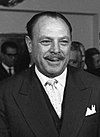
|
Ayub Khan
ایوب خان (1907, Rehana – 1974, Islamabad) |
1958 Pakistani coup d'état | 27 October 1958 | 8 June 1962 | — |
| (2) | 2 January 1965 | 8 June 1962 | 29 November 1963 | Pakistan Muslim League (C) | ||
| — | 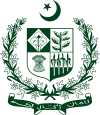
|
Mohammad Afzal Cheema
محمد افضل چیمہ |
— | 11 June 1962 | 29 November 1963 | — |
| — | 
|
Fazlul Qadir Chaudhry
فضل قادر چوہدھری |
— | 29 November 1963 | 12 June 1965 | Pakistan Muslim League (C) |
| (2) | 
|
Ayub Khan
ایوب خان |
2 January 1965 | 12 June 1965 | 31 March 1969 | Pakistan Muslim League (C) |
| 3 | 
|
Yahya Khan
یحییٰ خان |
— | 25 March 1969 [21] | 20 December 1971 | — |
| 4 | 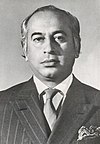
|
Zulfikar Ali Bhutto
ذولفقار علی بھٹو |
20 December 1971 | 20 December 1971 | 13 August 1973 | Pakistan Peoples Party |
| 5 | 
|
Fazal Ilahi Chaudhry
فضل الہی چودھری |
14 August 1973 | 14 August 1973 | 20 April 1978 [1] | Pakistan Peoples Party |
| — | 
|
Sheikh Anwarul Haq
شیخ انوار الحق |
— | 20 April 1978 | 7 May 1978 | Pakistan Peoples Party |
| (5) | 
|
Fazal Ilahi Chaudhry
ٖفضل الہی چودھری |
14 August 1973 | 7 May 1978 | 16 September 1978 [2] | Pakistan Peoples Party |
| 6 | 
|
Muhammad Zia-ul-Haq
محمد ضیا الحق |
— | 16 September 1978 | 17 August 1988 | — |
| 7 | 
|
Ghulam Ishaq Khan
غلام اسحاق خان |
13 December 1988 | 17 August 1988 | 18 July 1993 [3] | Independent |
| — | 
|
Wasim Sajjad
وسیم سجاد |
1995 Pakistani coup d'état attempt | 18 July 1993 | 14 November 1993 | Pakistan Muslim League (N) |
| 8 | 
|
Farooq Leghari
فارق لغاری |
14 November 1993 | 14 November 1993 | 2 December 1997 | Pakistan Peoples Party |
| — | 
|
Wasim Sajjad
وسیم سجاد |
— | 2 December 1997 | 1 January 1998 | Pakistan Muslim League (N) |
| 9 | 
|
Muhammad Rafiq Tarar
محمد رفیق تارڑ |
31 December 1997 1999 Pakistani coup d'état |
1 January 1998 | 20 June 2001 | Pakistan Muslim League (N) |
| 10 | 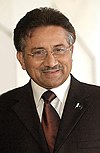
|
Pervez Musharraf
پرویز مشرف |
1 January 2004[n 2] | 20 June 2001 | 6 October 2007 | — |
| (10) | 6 October 2007 | 6 October 2007 | 18 August 2008 | Pakistan Muslim League (Q) | ||
| — | 
|
Muhammad Mian Soomro
محمد میاں سومرہ |
— | 18 August 2008 | 9 September 2008 | Pakistan Muslim League (N) |
| 11 | 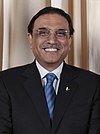
|
Asif Ali Zardari
آصف علی زرداری |
6 September 2008 | 9 September 2008 | 9 September 2013 | Pakistan Peoples Party |
| 12 | 
|
Mamnoon Hussain
ممنون حسین |
30 July 2013 | 9 September 2013 | 9 September 2018 | Pakistan Muslim League (N) |
| 13 | 
|
Arif Alvi
ڈاکٹر عارف علوی |
4 September 2018 | 9 September 2018 | Incumbent | Pakistan Tehreek-e-Insaf |
See also[]
- Governor-General of Pakistan
- Vice President of Pakistan
- Acting President of Pakistan
- List international trips made by the President of Pakistan
- List of prime ministers of Pakistan
- History of Pakistan
- Politics of Pakistan
- Political history of Pakistan
- Constitution of Pakistan of 1956
- Constitution of Pakistan of 1962
- Constitutional economics
- Constitutionalism
- List of heads of state of Pakistan
Notes[]
References[]
- ^ "The President's Role". Presidency of the Islamic Republic of Pakistan. Archived from the original on 7 November 2012. Retrieved 16 January 2013.
- ^ "Pakistan parliament agrees to curb presidential powers". BBC News. 8 April 2010. Retrieved 4 July 2012.
- ^ a b "The constitution of the islamic republic of pakistan" (PDF). National Assembly of Pakistan. Retrieved 4 July 2012.
- ^ a b "Previous Presidents". Presidency of the Islamic Republic of Pakistan. 25 April 2011. Archived from the original on 7 November 2012. Retrieved 16 January 2013.
- ^ Monitoring Desk (14 November 2012). "Former President Iskander Mirza remembered". The Frontier Post. Retrieved 16 January 2013.
- ^ "Iskander Mirza". PakistanHerald.com. Retrieved 16 January 2013.
- ^ "Wasim Sajjad". DailyPakistan.com. Archived from the original on 14 May 2013. Retrieved 16 January 2013.
- ^ "World: South Asia – Pakistan's army and its history of politics". BBC News. 12 October 1999. Retrieved 16 January 2013.
- ^ Fathers, Michael (18 August 1998). "Obituary: President Mohammad Zia ul — Haq". The Independent. Retrieved 16 January 2013.
- ^ Ali, Hasan (19 August 2008). "4 military dictators among 14 heads of state under Officers' Club of Revolutionary Armed Forces". Daily Times. Archived from the original on 16 April 2013. Retrieved 16 January 2013.
- ^ Aziz, Sartaj (2009). Between Dreams and Realities: Some Milestones in Pakistan's History. Karachi, Pakistan: Oxford University Press. p. 408. ISBN 978-0-19-547718-4. Archived from the original on 2013-09-19.
- ^ "Arif Alvi sworn in as 13th President of Pakistan". DAWN.COM. 9 September 2018. Retrieved 12 September 2018.
- ^ Matthew, H. C. G. (September 2004). "George VI". Oxford Dictionary of National Biography (online ed.). Oxford University Press. doi:10.1093/ref:odnb/33370. Retrieved 20 April 2008.
India and Pakistan remained among the king's dominions but both were set on republican courses, becoming republics within the Commonwealth in 1950 and 1956 respectively.
(Subscription or UK public library membership required.) - ^ Kumarasingham, Harshan (2013), THE 'TROPICAL DOMINIONS': THE APPEAL OF DOMINION STATUS IN THE DECOLONISATION OF INDIA, PAKISTAN AND CEYLON, vol. 23, Transactions of the Royal Historical Society, p. 223
- ^ "The Coronation of Queen Elizabeth II". Archived from the original on 2021-12-12. Retrieved 16 May 2014.
- ^ "The Form and Order of Service that is to be performed and the Ceremonies that are to be observed in the Coronation of Her Majesty Queen Elizabeth II in the Abbey Church of St. Peter, Westminster, on Tuesday, the second day of June, 1953". Oremus.org. Retrieved 2013-02-03.
- ^ https://www.thegazette.co.uk/London/issue/40020/supplement/6240 The London Gazette, no. 40020 of 20 November 1953, pp. 6240 ff.
- ^ John Stewart Bowman (2000). Columbia chronologies of Asian history and culture. Columbia University Press. p. 372. ISBN 978-0-231-11004-4. Retrieved 22 March 2011.
- ^ Page 7
- ^ "Commonwealth visits since 1952". Official website of the British monarchy. Archived from the original on 12 April 2015. Retrieved 4 September 2012.
- ^ Shahid Javed Burki, Craig Baxter Pakistan Under The Military: Eleven Years Of Zia Ul-haq (WESTVIEW SPECIAL STUDIES ON SOUTH AND SOUTHEAST ASIA) 1st Edition https://www.amazon.com/Pakistan-Under-Military-WESTVIEW-SOUTHEAST/dp/0813379857
- ^ Waldman, Amy (2 January 2004). "Pakistan gives Musharraf confidence vote as president". The New York Times. Retrieved 20 January 2013.
External links[]
"Presidents". WorldStatesman.org.
- Lists of national presidents
- Lists of political office-holders in Pakistan
- Presidents of Pakistan

